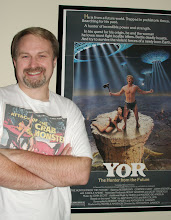
Author and cinema academic Nicholas G. Schlegel has
published his second book and it is just as welcome as his first, Sex,
Sadism, Spain and Cinema. That book insightfully discussed the dark
exploitation films of Spain’s Golden Age of Horror with an eye for what set them
apart from similar movies produced in Europe. This new books digs into another
sadly neglected subset of popular European film – the ‘krimi’. It is a
fascinating topic and one worthy of much attention. Schlegel points out how few
English language works exist that are focused on this years-long cycle and
seems to have chosen this subject out of a sense of filling this odd gap. Hopefully
this new work will spur more writers (and curious cinema thrill seekers) to pay
attention to this fascinating genre. I was pleased to learn in his introduction
that his journey of discovery mirrored my own in many ways, reminding me that
any attention brought to underappreciated areas of film can create new fans.
German Popular Cinema and the Rialto Krimi Phenomenon:
Dark Eyes of London is as meticulous and well researched as one could hope
for and as good as I expected. It is structured smartly to introduce neophytes
to the subject through a discussion of the history of post World War II German
cinema and the precursor films that lead to this type of thriller. This earlier
period of German cinema was completely unknown to me and it was educational to have
its evolution laid out in such a succinct and interesting fashion. He delineates
the various factors that led to the birth of the ‘krimi’ subgenre, explaining
the influences and peculiar requirements of the times, many of which were
unique to Germany. The author does an excellent job of pointing out the threads
that lead from one type of film to the next with our destination seeming to be
nearly inevitable. Clearly, the need for escapist entertainment is always a
driving force in the business but having some of the other influences laid bare
is fascinating.
Of course, there have always been crime films but rarely has
there been an odder combination of elements merging to create a fresh variation
like this. No matter how many examples of them a film fan may have encountered over
the years, a krimi will stand out in some way. Either a viewer will be amused
by the bizarre style of humor incorporated into the film’s story or be surprised
at the way violence is sometimes used to shock. Maybe the strange tone of the
film will draw attention to itself or the creepier elements will make the
entire affair feel more like a horror movie than a crime thriller. It is in
examining these odder elements of the genre where Schlegel’s book does its most
interesting and insightful work and luckily that is the bulk of the page count.
For over 130 pages of the text the book goes chronologically through the entire
run of thirty-two Rialto krimis giving both a brief plot synopsis and background
information on each. Folded into these entries Schlegel has included an
analysis of the film in question and makes note of how it fits into the slowly evolving
format of the series. He let’s his favorites be known but has much to say about
every film that comes under his gaze. This helps to make this new book
invaluable for both long time fans and those newly curious about this underseen
thriller form.
Without overstating the matter, German Popular Cinema and
the Rialto Krimi Phenomenon could be one of the most important new works on
genre films in a decade or more. For me, it is a necessary addition to my
reference library and a book that I know will serve to answer dozens of
questions as I continue to explore these fun thrillers. I highly
recommend this book to the newly curious and to the fan already enamored of the
genre. There is much food for thought within its pages.










No comments:
Post a Comment